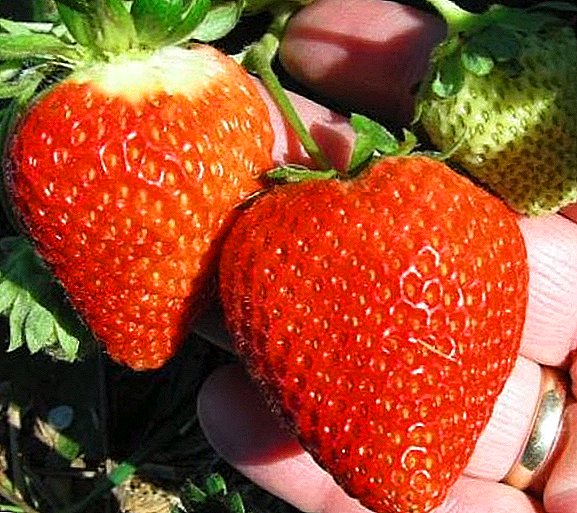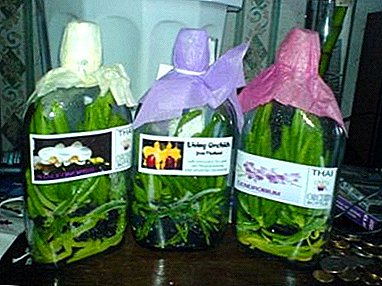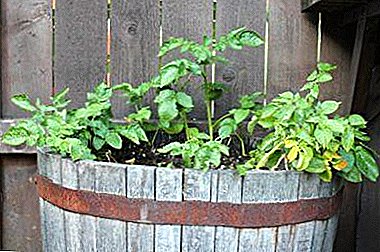 Ivan-tea is a plant of the family of females, which has many names: narrow-leaved willow, Koporsky tea, violin, weeping, down jacket, mother liquor, wild violet, shoemaker, winoder, empty house ... Today we will understand what merits he received for so many names.
Ivan-tea is a plant of the family of females, which has many names: narrow-leaved willow, Koporsky tea, violin, weeping, down jacket, mother liquor, wild violet, shoemaker, winoder, empty house ... Today we will understand what merits he received for so many names.
What it looks like and where it grows
The grass has a height of up to 1.5 meters and a straight stalk, often branching in the upper part. Leaves 5–12 cm long, above — light green, below — with dark green gray. The root system is thick, can move along the surface of the soil, with multiple processes, thanks to which the plant can be planted.
The length of the inflorescence can reach 40-45 cm, it has a spectacular appearance with a purple corolla and red sepals. This amazing in its properties and appearance of the plant in natural conditions is quite often found in many places in the northern hemisphere.  In Russia, Ivan tea is common in coniferous forests of the European part and in Siberia. The grass prefers sandstones on forest edges and forest glades, on railway embankments, next to crops of field plants.
In Russia, Ivan tea is common in coniferous forests of the European part and in Siberia. The grass prefers sandstones on forest edges and forest glades, on railway embankments, next to crops of field plants.
On fresh burns and cuttings, willow herb appears first, which is due to its pubescent seeds, capable of “catching” the tailwind, and spreading over vast distances. In this case, the seeds have a high survival rate and can be in the ground for several years in anticipation of a moment that is favorable for germination.
What parts of the plant are used for medicinal purposes
Ivan-tea is the plant that benefits when harvesting any part of it. Above-ground parts are recommended to be collected during the flowering of the crop - at this time leaves, stems and flowers are harvested. In May, young shoots appear, which break off during this period - before they have time to coarsen. Roots should be excavated in the last weeks of autumn.
We recommend to read when you need to collect willow-tea.

Drying leaves, stems and roots does not differ from the same manipulations with other plants - the raw material is sifted, cleaned of impurities and soil, and then dried in a room with free access of fresh air or in a special dryer.
Inflorescences require more thorough preparation, as the juice in them must be removed before preparing for drying. To do this, the twists of the brushes are manually pressed and kept in a dry place with ventilation for about 10 hours. After that, the raw materials are dried in the oven at a temperature of 100 ° C.
Did you know? The first tea producers in Russia in the 18th century collected willow tea near the village of Koporye (on the territory of the modern Leningrad Region), therefore, the fermented leaves of the plant were called "Koporsky tea."
Dry parts should be stored in a dark place in canvas bags or cardboard boxes. Such a container will help to keep the product in its normal humidity. 
Familiarize yourself with the beneficial properties of medicinal plants such as evading peony, three-leaf watch, hemlock, burnet, lespedean, half-fell, whitehead, barleyworm, onosma, creeping bitterberry and astragalus.
Chemical composition
Leaves of fireweed contain many beneficial substances that can help with inflammatory processes in the human body. Also, various drugs from green willow-tea help during the treatment of pathologies of the gastrointestinal tract such as colitis, gastritis, and ulcerative processes.
The plant contains such useful compounds:
- ascorbic acid (3 times more than in orange);
- carotene;
- tannin;
- pectin;
- sugar;
- alkaloids;
- minerals (copper, iron, manganese).
In Cyprus there are about 70 elements of the periodic table - more than half of its composition. 
What is useful and what treats
The plant, of course, is not an exclusive panacea for any diseases, but it is quite capable of alleviating the course or participating in the prevention of many ailments.
Cyprus can help with the following health problems:
- diseases of the gastrointestinal tract: colitis, gastritis, ulcer, pancreatitis, etc .;
- anemia;
For the treatment of anemia in traditional medicine they also use the centaury, hazel, blueberry, rocambole, zizifus, scorzonera, sunflower honey, periwinkle, black chokeberry and red mountain ash.
- inflammatory processes: from ordinary SARS, rhinitis and sore throats to inflammation of the male reproductive system and urolithiasis;
- hypertensive crisis, even in its serious manifestations and for various causes of occurrence;
- skin diseases, including herpes.
Separately, it is worth highlighting the benefits of willow tea in diseases of the human genitalia. In men, it is possible to treat prostatitis and prostate adenoma using plant extracts.  It helps women with diseases of the urogenital system such as thrush, cystitis, as well as with heavy menstrual flow. For both sexes, culture is useful for infertility.
It helps women with diseases of the urogenital system such as thrush, cystitis, as well as with heavy menstrual flow. For both sexes, culture is useful for infertility.
How to brew: recipes for use
Like many other medicinal plants, Ivan-tea is used in the form of tea, infusion, decoction or tincture on the alcohol material. Depending on the method of preparation, these or other useful properties of the plant appear brighter for the treatment of various ailments.
Tea
The recipe for tea from fireweed is simple: 2 teaspoons of crushed dry material (leaves, stems) are taken for a glass of boiling water. 10 minutes after infusion, the liquid is ready for use.
Given the richness of raw materials useful substances, tea leaves can be poured boiling water again. Also, to improve the taste and healthy qualities, you can add dried wild berries - blueberries, lingonberries, strawberries. 
Decoction
Broth from fireweed can be made not only from the above-ground parts of the culture, but also from the roots. Moreover, the nutrients contained in the rhizome, help and have a preventive effect in diseases of the respiratory system, and the drink from the leaves is useful for the treatment of gastric and intestinal pathologies.
Root Broth Recipe
A tablespoon of clean, dry roots is boiled in a glass of water for about 20 minutes. After that, the liquid is filtered and cooled. Apply one tablespoon 4 times a day.
Drinking sausep tea, pomegranate juice, flax seeds, watercress, walnut oil, wild honey also contributes to the normalization of the digestive tract.
Leaf Broth Recipe
A tablespoon of crushed dried leaves is boiled in 200 ml of water for 15 minutes. The resulting decoction is filtered, cooled and used for wiping wounds and bedsores, washing ulcers. Drink the infusion to normalize the activity of the gastrointestinal tract should be 3-4 times a day for a tablespoon. 
Did you know? At the end of 1941, on the orders of Hitler, all the plantations of willow, documentation, production facilities and specialists in Koporye were destroyed. This was done to ensure that the product did not get to the Soviet soldiers, who with its help recuperate and maintain morale. For the sake of this operation, Hitler even delayed the offensive on Leningrad for a day.
Infusion
Unlike broth, where you need to boil a small amount of material for some time, the infusion is prepared without boiling - a fairly large amount of dried grass is poured with boiling water and infused in a hermetically sealed container.
For the preparation of universal infusion of willow tea, take 2-3 tablespoons of dried, crushed leaves and 300-500 ml of boiling water, which is filled with plant mass. You can insist from 10 to 40 minutes. To treat problems with the pancreas, a warm infusion is applied 50 ml before and after each meal.  Ulcerative processes in the stomach can be weakened by taking 1/3 cup of drink per day. For skin diseases, the infusion is prepared in this proportion: two tablespoons of herbs are poured over 0.5 liters of boiling water, after which the composition is infused for 6 hours and is drunk in portions during the day.
Ulcerative processes in the stomach can be weakened by taking 1/3 cup of drink per day. For skin diseases, the infusion is prepared in this proportion: two tablespoons of herbs are poured over 0.5 liters of boiling water, after which the composition is infused for 6 hours and is drunk in portions during the day.
Alcohol tincture
Any useful plant can be a little differently showing its properties when insisting it on alcohol or vodka. Is not an exception and wormwood, which in combination with alcoholic beverages helps fight gastrointestinal diseases, colds and even tumors. It is possible to insist both dry and fresh leaves of willow-tea, as well as flowers.
- Tincture of dry leaves: two tablespoons of leaves are poured 200 mg of vodka and infused for about 10 days, then the composition is filtered.
- Tincture of fresh leaves and stems: half a cup of the collected material is washed and crushed, after which the raw material is poured 250 mg of vodka, infused for two weeks and filtered.
- Tincture of flowers of fireweed: two-thirds of a half-liter jar of flowers of the plant is poured to the top with vodka and infused in a dark place for two months and then filtered.
Important! Do not forget that any medication is applied sparingly. This is especially true for alcohol-based products.
Apply all three types of tinctures equally - from one teaspoon to one tablespoon three times a day. You can add medicine to tea or water.
Is it possible
With all the beneficial properties of the plant, some categories of people should be convinced of the possibility of using drugs derived from Ivan-tea.
Pregnant
At a minimum, teas brewed from the leaves of fireweed can be drunk to women during the period of carrying a child. Improving immunity, promoting normal formation and development of the fetus, improving blood circulation, normalization of metabolism - this plant will help in all of this. Also, it is a good sedative. 
Nursing women
Ivan-tea promotes lactation and improves the quality of milk, so it, of course, will be useful when feeding your baby. However, you should first consult with a specialist, and in the process of receiving funds with this grass carefully observe the reaction of the crumbs.
During lactation it is also useful to eat spinach, basil, radish, dill, shepherdia, sweet clover honey, ponirus, three-leafed and sweet clover.
For children
The anti-inflammatory properties of tea from fireweed can greatly alleviate the suffering of infants at the time of the appearance of the first teeth, but only if the child’s body is very difficult to tolerate this process.
Important! In case of problematic teething, a doctor may prescribe iwan tea, in other cases the plant is prohibited for infants.
When a child reaches the age of two years, drinking tea from tea is already allowed, but not more than 100 ml at one time, and not more than twice a day.
Contraindications and harm
Prolonged use of any drug can cause not only addiction, which levels all its useful qualities, but also a violation of the normal activity of the intestine.  Therefore, with a protracted course of using compositions with Ivan Chai (more than a month), it is necessary to make pauses - for the same period.
Therefore, with a protracted course of using compositions with Ivan Chai (more than a month), it is necessary to make pauses - for the same period.
Drinks from fireweed should be carefully used for various diseases related to bleeding disorders (varicose veins, thrombosis, thrombophlebitis). This fairly common plant attracts attention with its appearance, but in our time very few people were familiar with its excellent therapeutic and prophylactic properties.
However, with the promotion of a healthy lifestyle, willow tea began to gain fame, and drinks from different parts of this plant bring relief from many ailments.












